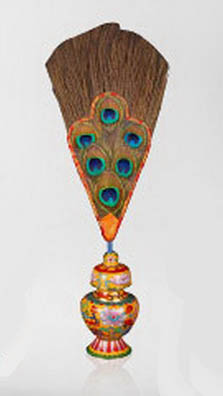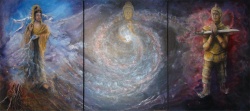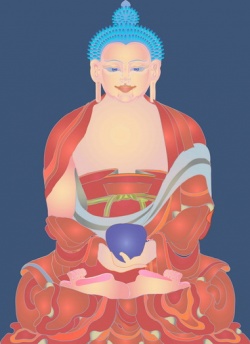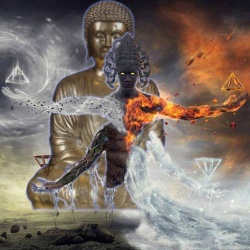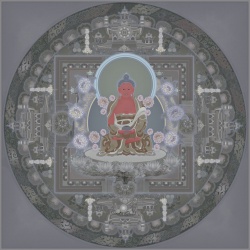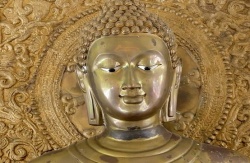Avici-mahaniraya
Avīci is the name of one of the most frightful hells (niraya , q.v.).Avici-mahaniraya
Source: A Dictionary of Buddhism, Oxford University Press, 2003, 2004 (which is available in electronic version from answer.com)
The nethermost of the eight hot hells, reserved for the most evil beings who must endure excruciating torments there, which though not eternal seem unending as they last for millions of years.
Source: Dictionary of Pali Proper Names, G P Malalasekera (1899-1973), which is available as printed version from
One of the eight great purgatories (mahāniraya) (J.v.266). It is ten thousand leagues in extent and forms part of a cakkavāla (SnA.ii.443).
The Milindapañha (p.5), however, places it outside the sphere of the earth.
Spence Hardy (Manual of Buddhism, p.26) mentions a tradition which says that Avīci is seven hundred miles directly under the Bodhi Tree at Gaya.
In later books, e.g. the Dhammapada Commentary, it is represented as being under the earth, for we are told that the earth opened wide to allow the flames of Avīci to escape and to drag down sinners into its bowels (E.g., DhA.i.127, 147; iii.181).
It seems to have been specially designed for those who had committed very grievous crimes, among whom are
Devadatta;
Cunda, the pork butcher;
Ananda, who raped his cousin the Therī Uppalavannā;
the ascetic Jambuka, who in a previous birth had insulted an arahant;
the murderer of the Pacceka Buddha Sunetta;
Sīvalī, who in a former birth had blockaded a city for seven years;
Suppabuddha, who insulted the Buddha;
Mallikkā, because of her misbehaviour with a dog (she was only there seven days);
Ciñcā-Mānavikā, because she falsely accused the Buddha;
and Kapila, brother of Sodhana, for reviling pious monks.
For details and references see under these names; see also Mil.357.
According to Buddhaghosa, Avīci is often called Mahā Niraya (AA.i.376). Descriptions of it are to be found in several places in the four Nikāyas (E.g., M.iii.183; A.i.141-2).
It is a quadrangular space, one hundred leagues each way, four-doored, walled all round and above with steel and with floor of incandescent molten steel.
The Dhammapadatthakathā gives a description of the tortures that await the entrant to Avīci.
When, for instance, Devadatta entered there, his body became one hundred leagues in height, his head, as far as the outer ear, entered into an iron skull;
his feet sank up to the ankles in iron, an iron stake as thick as the trunk of a palmyra tree came from the west wall, pierced the small of his back and, penetrating his breast, entered the east wall.
Other similar stakes came from the south and from the north and transfixed him (DhA.i.148).
The fire of Avīci is so powerful that it destroys the eyes of anyone looking at it from a distance of one hundred leagues (A.i.142).
It would destroy in a moment a rock as large as a gabled house, yet beings born there remain undestroyed, as though reposing in their mother's womb (DhA.i.127; Mil.67).
Beings born in Avīci suffer for periods of varying lengths; thus, Mallikā, Pasenadi's queen, remained only for seven days (DhA.iii.121), while Devadatta is destined to pass there 100,000 kappas (DhA.i.148).
The Sutta Nipata (p.126) gives the names of various specified periods of suffering, which, according to Buddhaghosa (SnA.i.476), are to be spent in Avīci; they are
taken in a geometrical progression of twenty (i.e. twenty Abbudas=one Nirabbuda, etc.).
Another mode of suffering in Avīci is described as Sarājita (SA.iii.100).
It is noteworthy that the word Avīci occurs only once in the four Nikāyas - namely, in a passage in the Cakkavatti-Sīhānāda Sutta of the Digha Nikāya (D.iii.75; repeated in A.i.159) - but in this context there is no indication that the name refers to a purgatory.
The word is not found in a list of purgatories given in the Sutta Nipāta (pp.126-31) and in the Samyutta (i.152).
It is, however, found in a poem in the Itivuttaka (No. 89) which recurs both in the Vinaya (ii.203) and in the Dhammasangani (Section 1280), and there it is specifically called a niraya.
In the Digha passage mentioned above, the reference to Avīci is in connection with a tremendous growth of population which will occur in Jambudīpa in a future age.
Houses will be so close that a cock could fly from any one to the next, and one would think it Avīci (avīci maññe).
Rhys Davids suggests (Dial.iii.73, n.1) that the word (which he translates as Waveless Deep) might have been originally used to denote density of population.
Buddhaghosa (DA.iii.855) explains it as "nirantara-pūrita" perhaps in the sense that it is filled with fire.
In the Visuddhi Magga (ii.449) the word appears to be a synonym for jars (disintegration) and is used in connection with the disintegration of earth, water, mountains, sun, moon, etc.
Avīci is often referred to as the lowest point of the universe (Thus, e.g.,Vsm.ii.390, 486; Mbv.57).
The chief suffering endured there is that of heat (MNidA., p.8).
Source: A.P. Buddhadatta Mahathera, Concise Pali-English and English-Pali Dictionary [available as digital version from Metta Net, Sri Lanka]
avīci : [adj.] waveless. (f.) one of the great hells.
Source: Pali-English Dictionary, TW Rhys Davids, William Stede,
Avīci [B.Sk. avīci a + vīci (?) no intermission, or no plea- sure (?), unknown, but very likely popular etym.] 1. avīciniraya, one of the (great) hells (see niraya), described in vivid colours at many passages of the Pāli canon, e.g. at Vin ii.203 = It 86; Nd1 18, 347, 405 = Nd2 304 iiid; Ps i.83; Dhs 1281; J i.71, 96; iii.182; iv.159; DhA i.148; PvA 52; SnA 290; Sdhp 37, 194; Pgdp 5 sq.; etc etc. -- 2. disintegration, decay Vism 449 (a. jarā nāma).
Source: Sanskrit-English Dictionary, by M. Monier William
a-vī7ci mfn. waveless L
• (is), m. a particular hell Yājñ. iii, 224 Buddh. &c
Source: Jeffrey Hopkins' Tibetan-Sanskrit-English Dictionary
[tenses]
mnar
mnar
mnard
mnard
[translation-san] {LCh,C} avīci
[translation-eng] {Hopkins} Most Tortuous; Most Torturous (Hell)
[comments] Comment: Name of the worst hell.
Source: Jeffrey Hopkins' Tibetan-Sanskrit-English Dictionary
[tenses]
mnar
mnar
mnard
mnard
[translation-san] {MSA} avīci
[translation-eng] {Hopkins} Most Tortuous Hell; denizen of the Most Tortuous Hell
